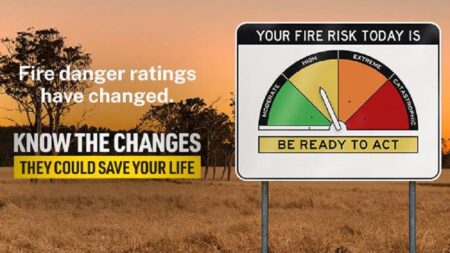NSW news: Bushfire Brigade gets ready for work
The bushfire season starts at different times in different places. Fire danger signs are going digital. Time for us all to get ready.Fire season is about to start. Fire danger rating signs on roadsides across NSW are getting a digital facelift, with the Rural Fire Service (RFS) set to provide real-time fire risk information to communities via remotely operated signs.
More than 200 digital fire warning signs are being rolled out, as the state approaches bushfire season.
The signs, which are powered by solar panels, are automatically updated each day in line with fire danger ratings on the RFS website. The ratings are informed by data from the Bureau of Meteorology.
The digital upgrade means RFS volunteers will no longer need to manually change the signs daily.
The signs use the revised Australian Fire Danger Rating System, which includes four categories for fire danger: Moderate (green), High (yellow), Extreme (orange) and Catastrophic (red), with simple actions for the community to take at each level. On days when there is minimal risk, ‘no rating’ is used.
The state’s north, where six local government areas are already in Bush Fire Danger Period, has been prioritised for the sign rollout.
From 1 September, a further 32 local government areas in the north and south of the state will enter the Bush Fire Danger Period, as warm, dry conditions increase the fire risk.
Eleven of the 32 areas are entering the danger period a month earlier than usual, with the prolific growth of vegetation after three years of wet weather adding to the heightened fire risk.
This comes as fire activity increases across NSW and bush fire emergency declarations are in place for the Kempsey, Nambucca and Clarence Valley local government areas, where 30 fires are burning.
Hundreds of volunteer firefighters, with the help of aircrews and the RFS’s new Chinook helicopter, are currently working to contain fires.
Western NSW
From 1 September, the following local government areas are beginning their Bush Fire Danger Period one month earlier than usual: Tamworth, Bogan, Coonamble, Walgett, Warren, Moree, Gwydir, Narrabri, Gilgandra, Warrumbungle, and Midwestern.
Coastal NSW
From 1 September, the following local government areas also begin their Bush Fire Danger Period: Muswellbrook, Singleton, Kempsey, Nambucca, Mid-Coast, Port Macquarie-Hastings, Clarence Valley, Ballina, Byron, Tweed, Bellingen, Coffs Harbour, Kyogle, Lismore, Richmond Valley, Gunnedah, Liverpool Plains, Upper Hunter, Bega Valley, Eurobodalla, and Shoalhaven.
Already in danger period
This is in addition to the six local government areas that commenced the danger period on 1 August: Armidale Regional, Walcha, Uralla, Glen Innes Severn, Inverell, and Tenterfield.
Once a Bushfire Danger Period commences landholders in these local government areas need to apply for a permit to burn off and notify their neighbours and local fire authorities 24 hours before lighting up.
Other News:
Enjoy our articles? Become a member of CPSA today for only $15.
Fire season is about to start. Fire danger rating signs on roadsides across NSW are getting a digital facelift, with the Rural Fire Service (RFS) set to provide real-time fire risk information to communities via remotely operated signs.
More than 200 digital fire warning signs are being rolled out, as the state approaches bushfire season.
The signs, which are powered by solar panels, are automatically updated each day in line with fire danger ratings on the RFS website. The ratings are informed by data from the Bureau of Meteorology.
The digital upgrade means RFS volunteers will no longer need to manually change the signs daily.
The signs use the revised Australian Fire Danger Rating System, which includes four categories for fire danger: Moderate (green), High (yellow), Extreme (orange) and Catastrophic (red), with simple actions for the community to take at each level. On days when there is minimal risk, ‘no rating’ is used.
The state’s north, where six local government areas are already in Bush Fire Danger Period, has been prioritised for the sign rollout.
From 1 September, a further 32 local government areas in the north and south of the state will enter the Bush Fire Danger Period, as warm, dry conditions increase the fire risk.
Eleven of the 32 areas are entering the danger period a month earlier than usual, with the prolific growth of vegetation after three years of wet weather adding to the heightened fire risk.
This comes as fire activity increases across NSW and bush fire emergency declarations are in place for the Kempsey, Nambucca and Clarence Valley local government areas, where 30 fires are burning.
Hundreds of volunteer firefighters, with the help of aircrews and the RFS’s new Chinook helicopter, are currently working to contain fires.
Western NSW
From 1 September, the following local government areas are beginning their Bush Fire Danger Period one month earlier than usual: Tamworth, Bogan, Coonamble, Walgett, Warren, Moree, Gwydir, Narrabri, Gilgandra, Warrumbungle, and Midwestern.
Coastal NSW
From 1 September, the following local government areas also begin their Bush Fire Danger Period: Muswellbrook, Singleton, Kempsey, Nambucca, Mid-Coast, Port Macquarie-Hastings, Clarence Valley, Ballina, Byron, Tweed, Bellingen, Coffs Harbour, Kyogle, Lismore, Richmond Valley, Gunnedah, Liverpool Plains, Upper Hunter, Bega Valley, Eurobodalla, and Shoalhaven.
Already in danger period
This is in addition to the six local government areas that commenced the danger period on 1 August: Armidale Regional, Walcha, Uralla, Glen Innes Severn, Inverell, and Tenterfield.
Once a Bushfire Danger Period commences landholders in these local government areas need to apply for a permit to burn off and notify their neighbours and local fire authorities 24 hours before lighting up.
Other News:
Enjoy our articles? Become a member of CPSA today for only $15.
